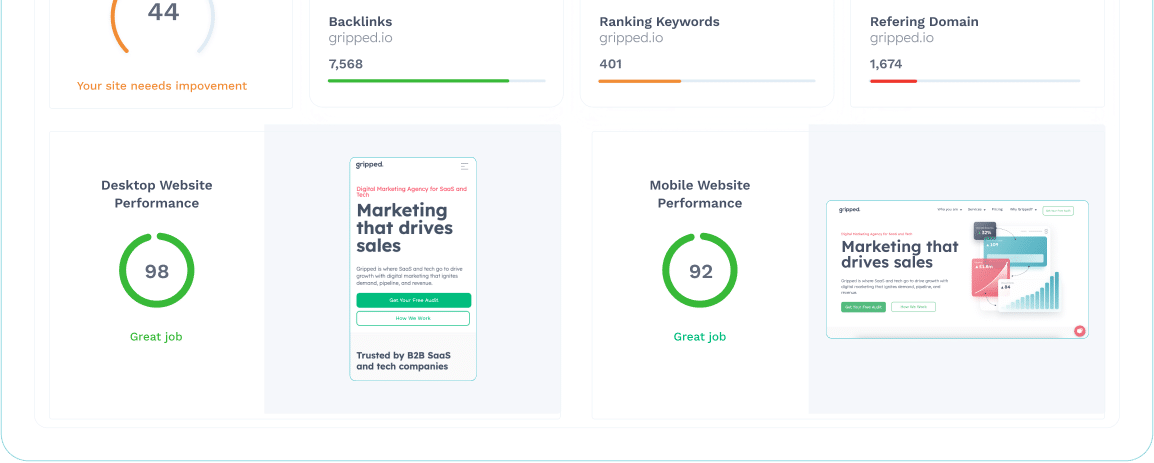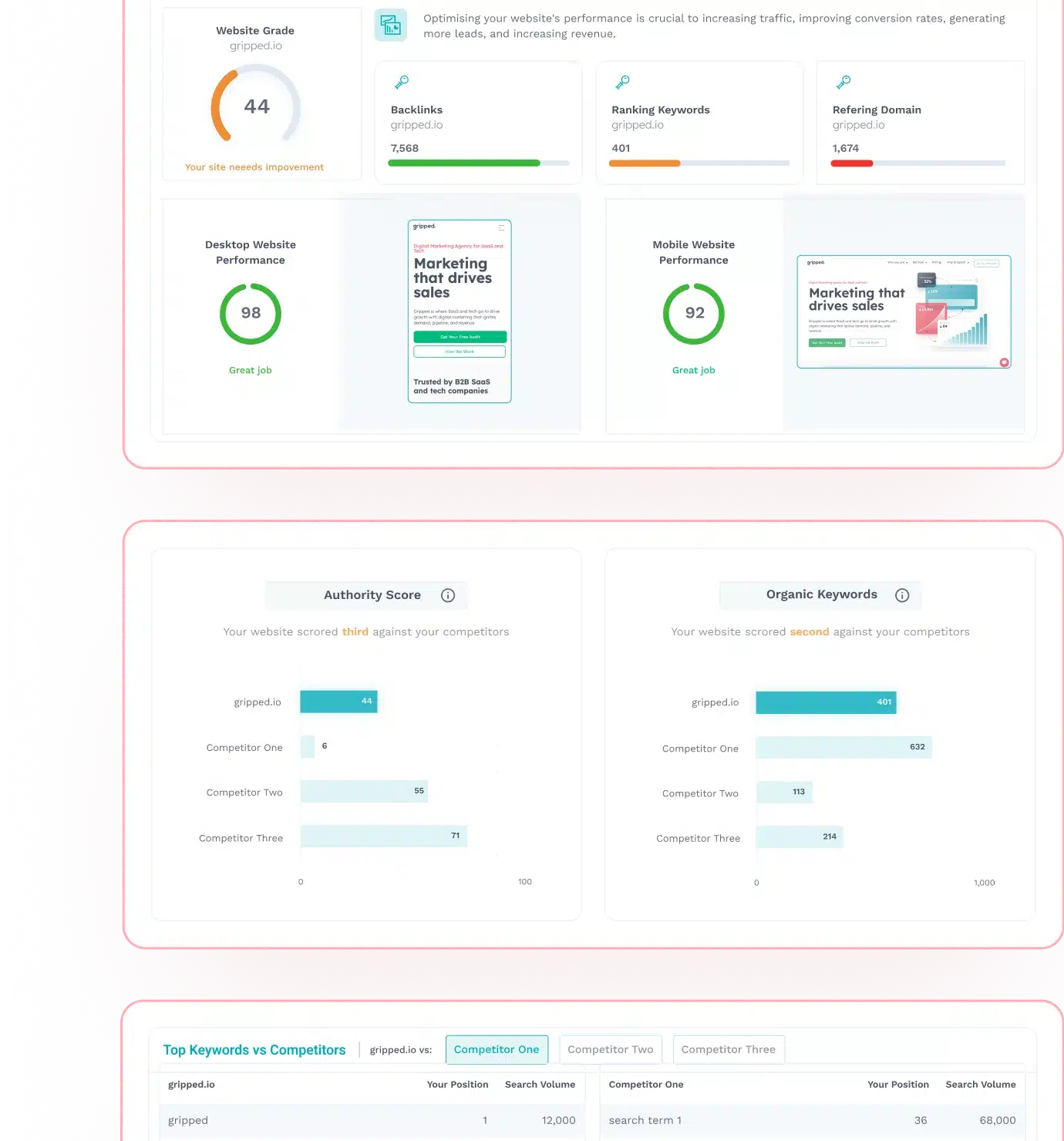A website is your online storefront, and an effective website strategy is crucial for marketing, converting sales, and attracting both customers and traffic. Remember, websites are becoming more important as consumers move towards digital channels in the post-Covid, post-social distancing world.
Is your website strategy effective?
Book your free audit today and find out!
Fundamentally, there’s a whole lot more to a website than just designing a pretty homepage. You need to strategise carefully in order to:
- Attract quality leads
- Keep customers engaged
- Convert leads into sales
Strategising, designing and building an effective B2B website can be difficult, time-consuming, and expensive. At Gripped, our team has extensive expertise and experience in helping B2B customers optimise their websites to generate more leads and improve business outcomes. In this article, we’re going to use all that knowledge to look at the three key stages of an effective B2B website strategy. Let’s get started.
Stage 1: Attraction
Any effective website strategy will focus first and foremost on attracting the right traffic. So, let’s take a look at four steps you can follow to start the process of attracting quality traffic to your website.
Step 1: Utilise the data you already have
Analysing the data you currently have on incoming traffic can help you understand and evaluate the audience you are speaking to through your brand. You also need to understand where this traffic is coming from, what they’re looking for, and what problems they are looking to resolve in order to tailor your website to their needs.

To attract quality leads and traffic, you need to understand your target market and use that knowledge to create relevant content. Not only does this provide value to your leads, but helps build a trusting relationship that you can nurture moving forwards.
Step 2: Invest time in SEO
Using Search Engine Optimisation (SEO) to improve website traffic is a tried and tested method that can deliver excellent results. If you dedicate the time and resources required to do SEO correctly, Google will reward your website with a higher ranking on search engine results pages (SERPs). And that means better visibility — and better leads!
SEO is about improving understanding of how your target audience uses Google, and then taking the necessary steps to maximise your visibility to those people. This ranges from narrative points (e.g. what subjects you talk about and how) to technical points (e.g. keywords, metadata, schema, page speed and more).
If you’re committed to utilising SEO effectively for your website, your next steps should be:

- Keyword research. What are the words that customers search for on Google to find your products and services? What words do you want to rank high for? Will these words bring you more quality traffic? If your keywords are not attracting high-quality traffic or leads, you need to review your keywords with a tool like SEMRush.
- Optimising your website copy with identified keywords. Optimisation is not all about stuffing keywords everywhere on your website. It’s about building relevant and engaging copy around those keywords.

See how your website stacks up against your competitors
Use our free online website grader to benchmark your search presence and SEO hygiene against your three closest competitors.

Step 3: Remember content is still King
You should look to complement your SEO efforts with an effective content marketing plan. Publishing high-quality content, built around your keyword research, is a great way to increase your ranking for search terms that your target customers will use to find your products and services.
Creating well-crafted, relevant content (like this article!), is a useful method of providing value to customers and encouraging them to interact with you more. Your content should help customers use your products and services, creating a more efficient customer service experience that can help increase customer loyalty, satisfaction and retention.
As well as helping you generate new leads, high-quality content can demonstrate your level of industry expertise, and build domain authority in the process. It’s important to remember, however, that you need to consistently produce content to maximise outcomes, as search engines reward sites that post new content regularly
Step 4: Take advantage of social media channels
Social media is a great tool for marketers for two reasons:
- It can help you find and target the right market segment
- It’s a great channel to engage with your customers and build loyalty
Being active on social media and engaging with new and existing customers not only increases your brand exposure and awareness, but more importantly, it is a simple and cost-effective method of increasing traffic to your site.

Whilst you should look to build a presence across several social media platforms, in the context of B2B websites, there is one you should prioritise — LinkedIn. Businesses in a variety of industries use this professional online space to engage with their followers and attract new customers, and you should too!
Stage 2: Nurture
After attracting the right target market to your business, you need to keep them interested and engaged with your brand, and eventually look to convert them into sales.
This can be achieved by:
- Developing your website user experience (UX)
- Creating relevant and targeted content
A smooth user experience on your website rests on a few key elements that you need to pay attention to in order to prevent a high bounce rate.
Don’t allow little things to let you down
Firstly, it’s absolutely critical that you avoid technical problems as much as possible. For example, quickly identifying and resolving broken 404 pages should be a priority. Furthermore, all links and CTAs should lead to a page that either calls for the customer to take action and purchase your product, or a page with relevant and engaging content.

The navigation of your site should also be straightforward and easy. Complicated websites with complex architecture are a nightmare for customers — all they want is a solution to their specific pain points. The harder it is to reach ‘purchase’ status, the less chances you have of your customer remaining on your website. Lastly, your website should always — and we mean always — be optimised with mobile users in mind.
This also comes back to content
A great UX is not the only way to nurture your leads. Targeting content is effective too. Your content should be relevant and valuable to your customers, not only to attract new leads, but also to keep them engaged. You should consider including a wide range of content formats on your website, such as case studies, FAQ pages, white papers, blogs, thought leadership pieces, and customer testimonials.
Stage 3: Conversion
Once you’ve done all the hard work, stage three of your new website strategy is the final and most important — converting the leads you’ve generated and thereby increasing sales.
There are two key elements to consider that can help you increase conversions:
- Website design
- On-page website copy
Let’s take a look at both of these in a little more detail.

Website design
You should look to utilise B2B web design best practices in order to achieve more conversions. It’s also important to consider your website design as interactive and animated.
Interactive websites encourage users to play around and participate willingly. An animated website is all about visuals and creating an eye-catching homepage that stands out from other brands, and emphasises your value proposition.
You should also pay close attention to the overall website design, as clear CTA buttons can go a long way. A qualified UX expert or a web designer experienced in building wireframes might be necessary, as a smooth user experience helps retain, nurture and ultimately convert leads.
Website copy
Your value proposition needs to be compelling, and should communicate both your brand value and core messages.

Your on-page copy also needs to be concise with a clear and simple message. Look at the words you are using to convey your message to potential customers. Is your copy purposeful, direct and powerful? Are you utilising words effectively in order to convince customers to go down the sales funnel? If not, your chances of converting leads are greatly diminished.
You can’t afford to cut corners
Your B2B website strategy needs both insightful content that adds value and a user experience that drives conversions. Any successful strategy will have attraction, nurturement and conversion at the forefront throughout. While this might sound simple, designing and implementing that strategy is far from easy.
In a competitive online marketplace falling behind just isn’t an option. However, having all the necessary skills and experience in-house to create and execute an effective website strategy comes at a considerable cost.
Partnering with a B2B marketing agency is a great way to ensure that each stage of your website strategy is designed and implemented in line with best practices without incurring extensive in-house costs.
If you’re ready to start using your website to attract more B2B leads and dramatically increase conversions, Gripped can help. Contact us today for your free growth assessment to get started.
